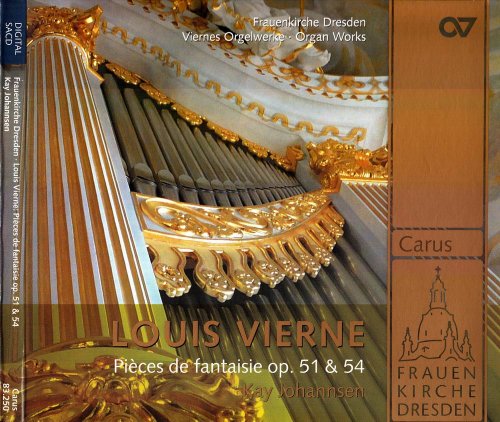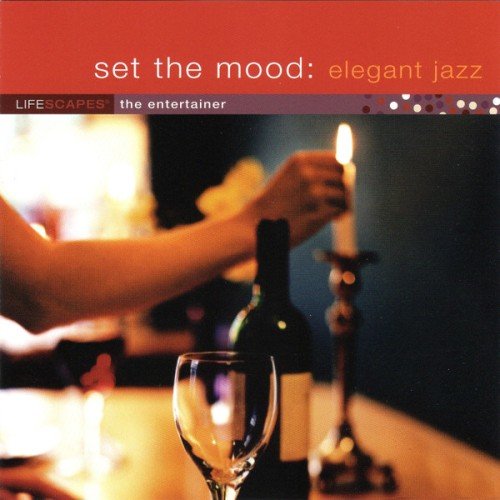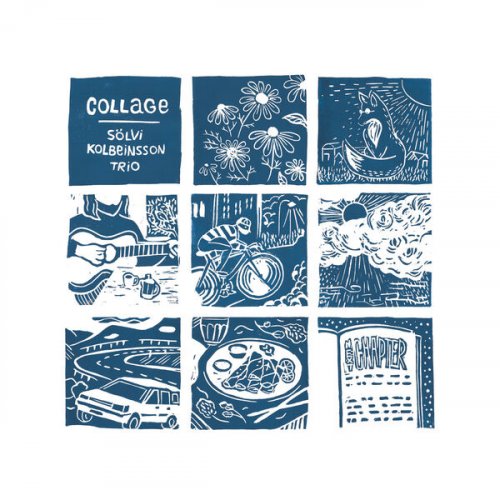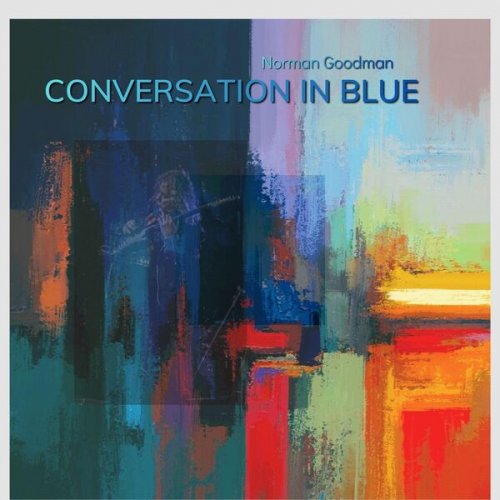Kay Johannsen - Louis Vierne: Pieces de fantasie op.51 & 54 (2008) [SACD]

Artist: Kay Johannsen
Title: Louis Vierne: Pieces de fantasie op.51 & 54
Year Of Release: 2008
Label: Carus - 83.250
Genre: Classical
Quality: DSD64 image (*.iso) / 2.0, 5.0 (2,8 MHz/1 Bit)
Total Time: 64:41
Total Size: 3.62 GB
WebSite: Album Preview
Tracklist:Title: Louis Vierne: Pieces de fantasie op.51 & 54
Year Of Release: 2008
Label: Carus - 83.250
Genre: Classical
Quality: DSD64 image (*.iso) / 2.0, 5.0 (2,8 MHz/1 Bit)
Total Time: 64:41
Total Size: 3.62 GB
WebSite: Album Preview
1. Suite I, op. 51 - Prelude
2. Suite I, op. 51 - Andantino
3. Suite I, op. 51 - Caprice
4. Suite I, op. 51 - Intermezzo
5. Suite I, op. 51 - Requiem aeternam
6. Suite I, op. 51 - Marche nuptiale
7. Suite II, op. 54 - Dedicace
8. Suite II, op. 54 - Impromptu
9. Suite II, op. 54 - Etoile du soir
10. Suite II, op. 54 - Fantomes
11. Suite II, op. 54 - Sur le Rhin
12. Suite II, op. 54 - Carillon de Westminster
In this volume of the Pieces de Fantaisie, Kay Johannsen pairs the first and third suites (the last movement of which is the extraordinarily popular Carillon de Westminster).
The first Suite's 6 movements are:
Prelude, Andantino, Caprice, Intermezzo, Requiem aeternum, Marche nuptiale
The second Suite's are:
Dedicace, Impromptu, Etoile du soir, Fantomes, Sur le Rhin, Carillon de Westminster
Johannsen's registration starts as though he wishes to draw a veil over proceedings and when a "bright" reed emerges in Caprice, it heightens the expressive effect. Added to the somewhat gloomy mood is the preponderance of the melodic line in the pedals. Johannsen makes the most of this somewhat lugubrious music and copes admirably with the chromaticism - remarkably even execution so it seems to meander disconsolate in Requiem aeternum. Unsurprisingly, the Marche nuptiale has a very different feel, tempo and scale to the rest of the first Suite but it still has its fair share of emotional and tonal ambiguity.
The third Suite is conceived on a larger scale altogether - nearly half as long again as the first. Although it shares the same chromaticism of the first Suite, Dedicace that opens the third Suite is altogether sunnier in disposition and Johannsen's playing rightly reflects the change of mood. Impromptu is given a delightfully playful reading and reminds one of the better accounts of some Chopin going under the same name. Etoile du soir has both an evocative name but more beneficially for listeners a persuasive account of what must count as the most exploratory piece harmonically on this disc. And Fantomes is simply thrilling here - the subterranean reed gnaws into the ears in the slow sections and the apparitions are suitably transparent. Sur le Rhin is a depiction of the Rhine rather in the manner of Schumann's depiction of Cologne Cathedral rather than the Impressionist approach that many of Vierne's compatriots adopted and sounds very grand here. The most famous piece on this disc by far is the concluding Carillon de Westminster and is based on a theme that makes Londoners feel at home the world over - the chimes which precede Big Ben. Johannsen performs, as with the remainder of the disc, musically and with panache - it's a tremendously exciting end to a wonderful recital.
Fortunately the Carus recording (co-production with the Frauenkirche Dresden) is wonderful and gives a tangible sense of the acoustic and the organ's position within it.
The first Suite's 6 movements are:
Prelude, Andantino, Caprice, Intermezzo, Requiem aeternum, Marche nuptiale
The second Suite's are:
Dedicace, Impromptu, Etoile du soir, Fantomes, Sur le Rhin, Carillon de Westminster
Johannsen's registration starts as though he wishes to draw a veil over proceedings and when a "bright" reed emerges in Caprice, it heightens the expressive effect. Added to the somewhat gloomy mood is the preponderance of the melodic line in the pedals. Johannsen makes the most of this somewhat lugubrious music and copes admirably with the chromaticism - remarkably even execution so it seems to meander disconsolate in Requiem aeternum. Unsurprisingly, the Marche nuptiale has a very different feel, tempo and scale to the rest of the first Suite but it still has its fair share of emotional and tonal ambiguity.
The third Suite is conceived on a larger scale altogether - nearly half as long again as the first. Although it shares the same chromaticism of the first Suite, Dedicace that opens the third Suite is altogether sunnier in disposition and Johannsen's playing rightly reflects the change of mood. Impromptu is given a delightfully playful reading and reminds one of the better accounts of some Chopin going under the same name. Etoile du soir has both an evocative name but more beneficially for listeners a persuasive account of what must count as the most exploratory piece harmonically on this disc. And Fantomes is simply thrilling here - the subterranean reed gnaws into the ears in the slow sections and the apparitions are suitably transparent. Sur le Rhin is a depiction of the Rhine rather in the manner of Schumann's depiction of Cologne Cathedral rather than the Impressionist approach that many of Vierne's compatriots adopted and sounds very grand here. The most famous piece on this disc by far is the concluding Carillon de Westminster and is based on a theme that makes Londoners feel at home the world over - the chimes which precede Big Ben. Johannsen performs, as with the remainder of the disc, musically and with panache - it's a tremendously exciting end to a wonderful recital.
Fortunately the Carus recording (co-production with the Frauenkirche Dresden) is wonderful and gives a tangible sense of the acoustic and the organ's position within it.
![Kay Johannsen - Louis Vierne: Pieces de fantasie op.51 & 54 (2008) [SACD]](https://www.dibpic.com/uploads/posts/2021-04/1619776679_back.jpg)


![Cornelius Claudio Kreusch - Scoop (2025) [Hi-Res] Cornelius Claudio Kreusch - Scoop (2025) [Hi-Res]](https://www.dibpic.com/uploads/posts/2025-12/1765893706_folder.jpg)





![NYO Jazz - Live in Johannesburg (Live) (2025) [Hi-Res] NYO Jazz - Live in Johannesburg (Live) (2025) [Hi-Res]](https://www.dibpic.com/uploads/posts/2025-12/1765894703_zwp14vk90corb_600.jpg)